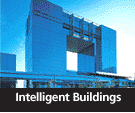



AutomatedBuildings.com
|
[an error occurred while processing this directive] |
| What is an Intelligent Building? | Ken Sinclair, Editor |
[an error occurred while processing this directive]I just became aware of this Association which deals with Intelligent Buildings and Intelligent Community. I have copied information from their site to enable you to quickly gain an understanding of their purpose and reach. In their Guide to an Intelligent Building they answer in their terms What is an Intelligent Building? I have included a portion of this definition for your information. Please visit their web site and review their resources and links to members.
World Teleport Association http://www.worldteleport.org/
World Teleport Association WTA is a nonprofit trade association representing the key commercial players in broadband. WTA’s members in 20 nations includes teleports, satellite and terrestrial carriers, technology providers, engineering firms, investment houses and consultants. Through our special interest project, the Intelligent Community Forum, WTA also attracts property developers and governments as members. Developers of intelligent buildings turn to WTA for expertise in using broadband to build property value. Governments on the local, regional and national level seek to use broadband for economic development.
For members, WTA is the global body that promotes their interests, researches their market, feeds them sales leads from around the world, and connects them to strategic allies.




What is an Intelligent Building?
Typical
Features of Intelligent Buildings
Developers
of Intelligent Buildings view broadband telecommunications as an essential tool
for attracting tenants in fast-growth industries that have a strong demand for
facilities. While there is no standard engineering or architectural definition
of "intelligence" in a building, typical features include:
High ceilings that allow room for the construction of the raised floors required for data center cabling
Industrial-grade flooring able to support heavy equipment loads
Heavy-duty HVAC systems to provide heat-producing electronic equipment with a stable temperature environment
Redundant access to multi-megawatts of electric power, with backup batteries and generators to insure uninterruptibility
High-capacity risers that permit optical fiber runs by multiple carriers from redundant sources
Adequate rooftop space, with convenient access to in-building fiber or other communications circuits, for wireless local loop, conventional cellular and satellite antennas
Access
to Telecomunications Facilities and Services
Developers
of Intelligent Buildings differ in their approach to providing tenants with
access to telecommunications facilities and services. In some cases, developers
authorize one or more companies as exclusive service providers for their
tenants, and these service providers frequently create value-added services for
the building, such as online access to building management services and
Web-based "shopping malls" where tenants gain online access to local
retailers and services. In other cases, developers specifically aim to create a
"carrier-neutral backbone," which offers tenants a broad selection of
service providers, but controls how those providers access in-building
facilities in order to prevent disruptions.
1980s:
First Developments
Intelligent
Buildings were first constructed in the 1980s, but failed to develop a critical
mass in the real estate industry. One of the most successful projects was The
Teleport, a development of the Port Authority of NY & NJ on New York
City’s Staten Island, which opened in 1985. A founding tenant of The Teleport
was Telehouse International Corporation, which created what would today be
recognized as the first commercial collocation facility, where companies located
their computers and telephone switches in order to have access to both local and
long-distance networks at low cost.
1990s:
Telecom Hotels
Despite
this early success, by 1990, most developers had dismissed the Intelligent
Building concept as a marketing "gimmick." But less than a decade
later, Intelligent Buildings had become the hottest play in real estate, because
of the unexpected success of the model pioneered by Telehouse in 1985.
Telehouses — also known as telecom hotels, Internet data centers or hosting
centers — experienced explosive growth beginning in 1998. Driving development
was the exponential growth of Internet traffic and the inability of incumbent
local telephone carriers to provide enough space at their central offices for
all of the equipment that competitive service providers wanted to install. With
a broadband connection into a central office (for local connectivity) and
another broadband connection to a Tier 1 Internet backbone carrier, telehouses
provide the equivalent of collocation space at a facility outside the central
office or backbone carrier’s facility.
21st
Century: Accelerated Pace of Development
Today,
companies including real estate developers, telecommunications carriers,
information technology companies and new startups continue to develop telehouses
at a furious pace. (Telehouse International itself operates three telehouses in
New York City, one known as the New York Internet Exchange.) Growth in this
marketplace is very strong: the city of London had about 1 million square feet
of telehouse space in mid-2000, and was forecast to have 10 million square feet
by 2007, while New York City saw 4.9 million square feet purchased or leased for
telehouse space in the 18 months from mid-1998 to the end of 1999.
World Teleport Association http://www.worldteleport.org/
[an error occurred while processing this directive]
[Click Banner To Learn More]
[Home Page] [The Automator] [About] [Subscribe ] [Contact Us]